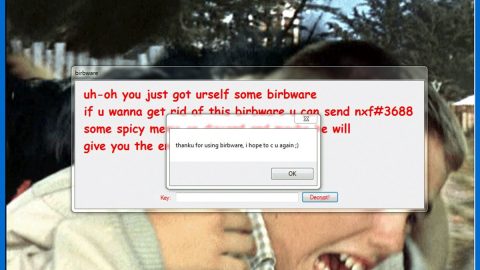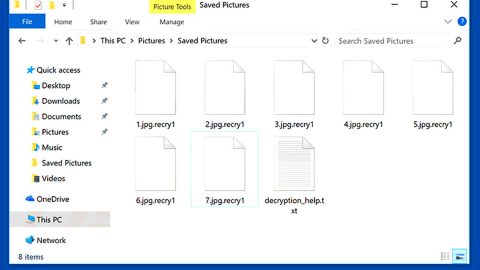What is Kali ransomware? And how does it execute its attack?
Kali ransomware is a file-locking malware discovered recently. It extorts users into paying $500 in BTC in exchange for file recovery. It uses the AES 256 encryption algorithm in encrypting its targeted files. Once its malicious payload is activated in a targeted system, it starts to execute its attack by establishing a connection to a remote Command and Control server controlled by the attackers.

After it establishes a connection, Kali ransomware will download its malicious components from this remote server and place them in system folders. This allows the crypto-malware to control system processes. It then employs a data gathering module which is used to gather information from the infected computer. The harvested data will then be used for the next module called stealth protection used to scan digital signatures of security and antivirus programs installed in the system.
Once it finds these programs, it either disables them or completely removes them from the computer to keep them from interfering with the attack. Moreover, Kali ransomware also alters some registry keys and sub-keys in the Windows Registry which allows it to run on every system startup automatically. Once all the system changes are applied, it starts encrypting its targeted files using the AES 256 encryption algorithm. Following data encryption, it appends the .kali extension to every file affected and releases a text file named “HOW TO DECRYPT FILES.txt” which contains the following message:
“ATTENTION ! ! !
The important files on your computer have been encrypted
with military-grade AES-256 bit encryption.
The only way to get access to your files – enter the decryption key.
We guarantee that you can recover all your files safely and easily.
All you need to do is submit the payment and purchase the private key.
- Send $500 worth of Bitcoin to the following address:
3Ge8TedVhoYum3q1DAN42wVftkhH9MRVm2
If you don’t know about Bitcoin you can buy it from here:
www.coinbase.com or www.localbitcoins.com or try google.com
- After payment send your ID and contact email to:
[email protected]
YOUR ID: –
and we will send INSTRUCTIONS and KEY for recovery.
IMPORTANT: YOU HAVE ONLY 48 HOURS FOR PAYMENT
PLEASE DON’T EVEN TRY TO RECOVER FILES BY YOURSELF
IN CASE IF YOU WILL TRY TO DO SOMETHING WITHOUT KEY
ACCESS TO YOUR FILES WILL BE PERMANENTLY LOST!
DON’T EVEN TOUCH ANYTHING! OR
ACCESS TO YOUR FILES WILL BE PERMANENTLY LOST!”
How does Kali ransomware spread over the web?
Kali ransomware, just like a typical crypto-virus, spreads via phishing attachments. Cyber crooks often attach malicious files and send them to users using spam botnets. This malicious file may be an executable file, PDF file, ZIP file, documents that all have scripts used to launch Kali ransomware in the system.
Kill Kali ransomware with the help of the removal instructions given below.
Step_1: Open the Task Manager by simply tapping Ctrl + Shift + Esc keys on your keyboard.
Step_2: Under the Task Manager, go to the Processes tab and look for the suspicious-looking process that takes up most of your CPU’s resources and is most likely related to Kali ransomware.
Step_3: After that, close the Task Manager.
Step_4: Tap Win + R, type in appwiz.cpl and click OK or tap Enter to open Programs and Features under Control Panel.
Step_5: Under the list of installed programs, look for Kali ransomware or anything similar and then uninstall it.
Step_6: Next, close the Control Panel and tap Win + E keys to launch File Explorer.
Step_7: Navigate to the following locations below and look for Kali ransomware’s malicious components such as HOW TO DECRYPT FILES.txt, [random].exe, and other suspicious files, then delete all of them.
- %TEMP%
- %WINDIR%\System32\Tasks
- %APPDATA%\Microsoft\Windows\Templates\
- %USERPROFILE%\Downloads
- %USERPROFILE%\Desktop
Step_8: Close the File Explorer.
Before you proceed to the next steps below, make sure that you are tech-savvy enough to the point where you know exactly how to use and navigate your computer’s Registry. Keep in mind that any changes you make will highly impact your computer. To save you trouble and time, you can just use Restoro, this system tool is proven to be safe and excellent enough that hackers won’t be able to hack into it. But if you can manage Windows Registry well, then by all means go on to the next steps.
Step_9: Tap Win + R to open Run and then type in Regedit in the field and tap enter to pull up Windows Registry.
Step_10: Navigate to the following path:
- HKEY_CURRENT_USER\Control Panel\Desktop\
- HKEY_USERS\.DEFAULT\Control Panel\Desktop\
- HKEY_LOCAL_MACHINE\Software\Microsoft\Windows\CurrentVersion\Run
- HKEY_CURRENT_USER\Software\Microsoft\Windows\CurrentVersion\Run
- HKEY_LOCAL_MACHINE\Software\Microsoft\Windows\CurrentVersion\RunOnce
- HKEY_CURRENT_USER\Software\Microsoft\Windows\CurrentVersion\RunOnce
Step_11: Delete the registry keys and sub-keys created by Kali ransomware.
Step_12: Close the Registry Editor and empty the Recycle Bin.
Try to recover your encrypted files using the Shadow Volume copies
Restoring your encrypted files using Windows Previous Versions feature will only be effective if Kali ransomware hasn’t deleted the shadow copies of your files. But still, this is one of the best and free methods there is, so it’s definitely worth a shot.
To restore the encrypted file, right-click on it and select Properties, a new window will pop up, then proceed to Previous Versions. It will load the file’s previous version before it was modified. After it loads, select any of the previous versions displayed on the list like the one in the illustration below. And then click the Restore button.
Congratulations, you have just removed Kali Ransomware in Windows 10 all by yourself. If you would like to read more helpful articles and tips about various software and hardware visit fixmypcfree.com daily.
Now that’s how you remove Kali Ransomware in Windows 10 on a computer. On the other hand, if your computer is going through some system-related issues that have to get fixed, there is a one-click solution known as Restoro you could check out to resolve them.
This program is a useful tool that could repair corrupted registries and optimize your PC’s overall performance. Aside from that, it also cleans out your computer for any junk or corrupted files that help you eliminate any unwanted files from your system. This is basically a solution that’s within your grasp with just a click. It’s easy to use as it is user-friendly. For a complete set of instructions in downloading and using it, refer to the steps below
Perform a full system scan using Restoro. To do so, follow the instructions below.













